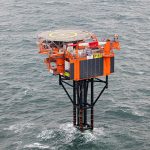Thanks to the ground-breaking Oranje-Nassau Standard Satellite (ONSS) platform, ONE-Dyas was able to commercially exploit two marginal fields in the face of low gas prices. A unique combination of solar and wind power allowed the facility to operate with zero emissions. Designed for reuse, the ONSS is now waiting for a new project, while the field will be decommissioned in a safe and environmentally friendly manner.
ONSS concept
Relatively few undeveloped gas prospects remain on the Dutch Continental Shelf. Discovering new, commercially viable developments has become a significant challenge for the industry.
In response, ONE-Dyas partnered with GeoSea N.V. to develop the ground-breaking Oranje-Nassau Standard Satellite (ONSS) to cost-effectively develop marginal fields. The platform design significantly simplifies and shortens the engineering process, making first gas highly achievable within eighteen months.
The ONSS consists of a standard topside design combined with a modular jacket. Although small, the topsides incorporate a free-water knockout facility, three well-slots, a tie-in for a subsea well, a tie-in from another ONSS, an export riser with the provision for piggy-backline, and a J-Tube or an umbilical.
The unmanned satellite is also equipped with an emergency shelter for eight people, a helicopter deck, and a five-ton crane. In addition, a number of wind turbines and solar panels generate power for emission-free operation.
The topsides can be used for a wide range of gas fields up to two million m3/day gas throughput without the need for any modification.
The modular jacket, meanwhile, can operate at depths of up to 50 metres, making it suitable for any location in the southern North Sea. The design is certified for use in both United Kingdom and Dutch waters.
The modular jacket and the topside were both constructed by Heerema, while the platform itself was installed by DEME Group.
The process
The ONSS separated water from the gas and condensate, which were then exported via a new pipeline installed by Allseas.
9km long, with an 8” diameter and a 2” methanol injection line, this new pipeline connected to the existing pipeline from P15-F to P15-D.
It then proceeded to navigate nine metre-high sand dunes, telecommunication cables, old pipelines, and future wind turbines before connecting to the TAQA-operated P15-D processing facilities.
Decommissioning
The decommissioning will be done in two parts: removing the topside and removing the jacket. Wednesday, 6 September, the vessel called Gulliver departed and will deliver the topside of the platform to the storage yard of SAGRO. After delivering the topside, the Gulliver will return to the location and pick up the jacket. A survey of the seabed will be done before departing location, to ensure no foreign objects are left behind. After removal, the P11-E platform will be loaded-in at a storage yard for storage and refurbishment or dismantling.
The project
The ONSS was deployed for the first time on the P11-11 and P11-12 gas fields located 50 kilometres off the Dutch North Sea coast. ONE-Dyas and our partners TAQA Offshore B.V. and EBN B.V discovered the P11-11 field in the spring of 2014. A subsequent well was drilled from the platform and discovered P11-12.
P11-E became the first offshore development completely managed by ONE-Dyas from exploration discovery through to production, highlighting our capability to successfully develop offshore marginal gas fields on time and on budget.
At just 28 months the time between discovery and first gas from the P11-11 field was described by CGG as ‘the fastest turn around in the Dutch offshore of the last 13 years.’ Operations commenced in October 2016 and the platform went on to produce 636 million Nm3 gas before production ceased in May 2020.
According to Energie Beheer Nederland (EBN), the projects also demonstrated the way forward for an industry under pressure. It was safely executed and provided lower carbon energy in a cost-effective manner while moving forward through the energy transition.
Safety and environment
In terms of safety, a fully closed fire- and explosion-resistant wall separates the processing and non-processing area.
The platform is also equipped with gas and fire detection, while the helideck features an independent dedicated high-pressure water and foam fire extinguishing system. On the P11-E project, an early warning vessel anti-collision system (AIS) was monitored from the Q16 Maas control room.
To minimise environmental impact as far as possible, the platform has been constructed from a lightweight design, saving 500kg CO2 per ton of steel. With power generated by solar and wind and stored in batteries, the ONSS operates with near-zero emissions.
The unmanned platform means helicopter and supply boat activities are kept to a minimum. The diesel generator for the helideck system is only active during manning to limit NOx emissions. And the helideck foam extinguishing system is tested onshore and only needs retesting every five years.
Emissions from overboard water to the sea are limited to less than 20ppm and the platform would automatically shut down should this be exceeded.








